The
unusual concave and convex front of the "new" cathedral (shown above)
fronts one of the larger squares and faces the center of the island.
Obviously the new wealth pouring into Cadíz immediately
after it
received the trade monopoly called for a more elaborate
Baroque/neo-Classical cathedral, in this case designed by (at least at
first) by Vincente
Acero.
Acero's family stretched back to the invading Berbers in 711. He served
as master architect of many Spanish and North American cathedrals and
possibly of many of the ships in the ill-fated Spanish Armada. The
towers were added in the 19th century by Juan de la Vega.
An eclectic interior
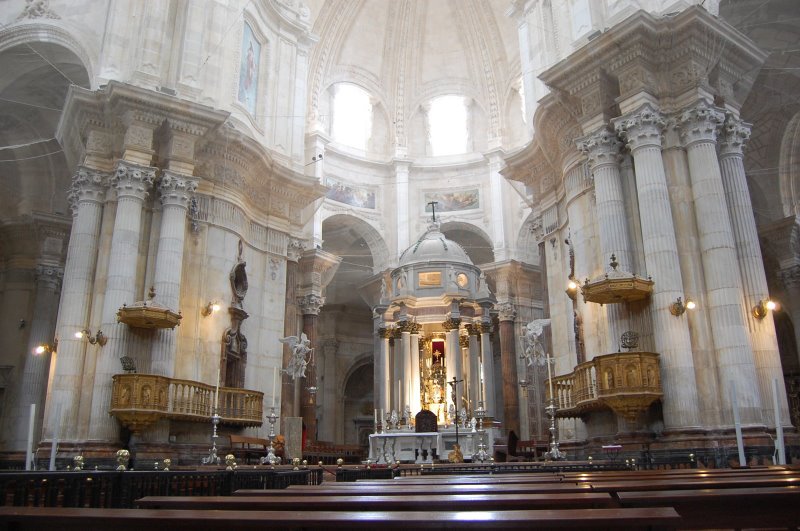
Since it took nearly 120 years to build, several architects served in
the role of master builder -- good if you like eclecticism, bad if you
prefer consistency. Either way, this is a gorgeous place of elegant
symmetry floating above its triple-nave Latin cross plan: note the two
gold pulpits which frame the octagonal tabernacle enclosure under its
matching dome. Corinthian columns abound making the huge support for
the dome look rather graceful.
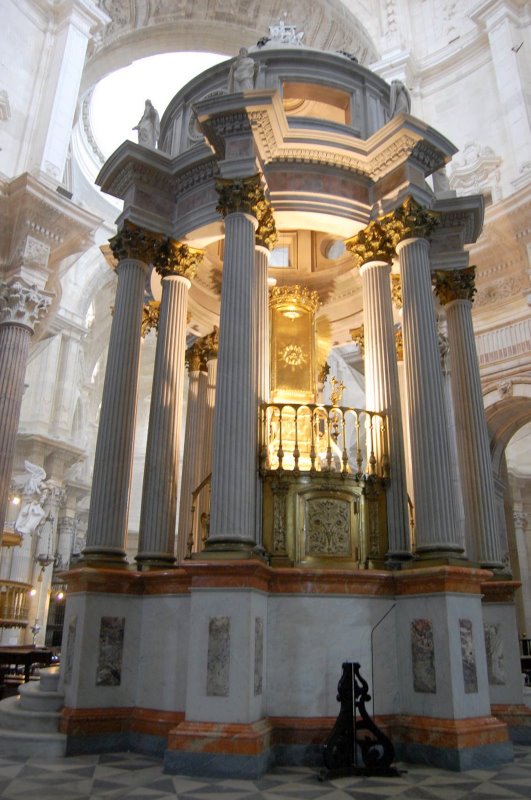 At left: A view
from the back of the tabernacle whose double Corinthian columns suggest
an ancient Greek temple
At left: A view
from the back of the tabernacle whose double Corinthian columns suggest
an ancient Greek temple
Below is a closer look at the cathedral's neo-classic dome. On the
outside, it's a
golden dome that seems to float in the clouds when the fog surrounds
Cadíz. But inside, this cathedral (with the exception of the
tabernacle) does not try to overwhelm with silver and gold as do other
Andalusian cathedrals like the one in Seville. (However,
Cadíz
displays its wealth from the Indies in the Cathedral's museum which we
shall see next.) Here the stately marble and classic forms surround the
worshiper. Note the simplicity of its pendentives (those triangles that
make this dome look a bit like a four-pointed star)
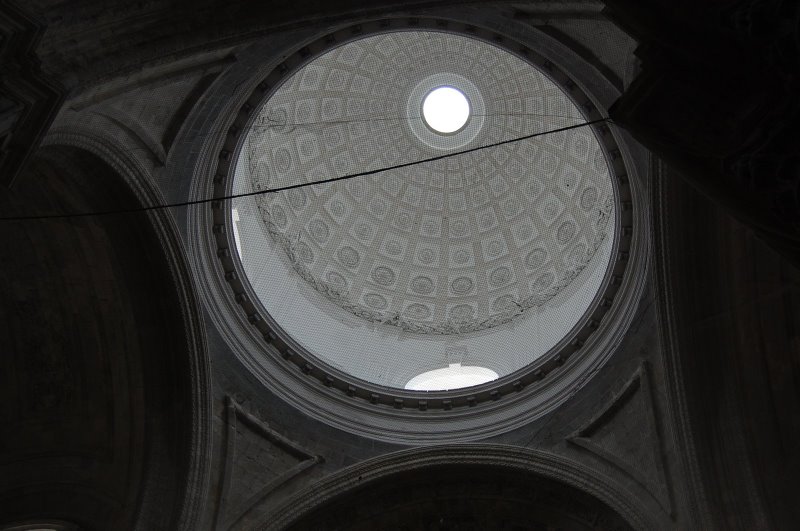
Cornejo's Choir
Funny that in this city
sparkling with New World gold and silver, the wooden choir is the
most decorated area of its cathedral. Pedro Duque
Cornejo carved its stalls. The "throne area" at center provides an
unusual focal point we
hadn't noticed before. My guess would be that this area serves as a
chapter house where the bishop presided over meetings
with clerics.
After all, the Latin word for a chair with arm rests is "cathedral" --
and it was typically reserved for the emperor until bishops
stole the
idea in the 4th century. Usually the bishop's throne is found near the
main altar.
Given that it took 116 years to build, the Cathedral shows elements of
the styles that flourished during that period: Baroque, Rococo and
Neoclassical. But Cornejo's choir somehow feels downright medieval.
(Note: you may need to
doubleclick to enlarge the small pictures above to see this kind of
detail:) The upper cherubs seem to have started an
orchestra. (They probably
have that kind of time.) They stand above a row of bust reliefs of
female saints who are supported by some hard working cherubs with backs
bent under the load. Below them stand the men with Jesus and Mary on
each side of the throne emblazoned with a gold emblem of a bishop.
Side Chapels
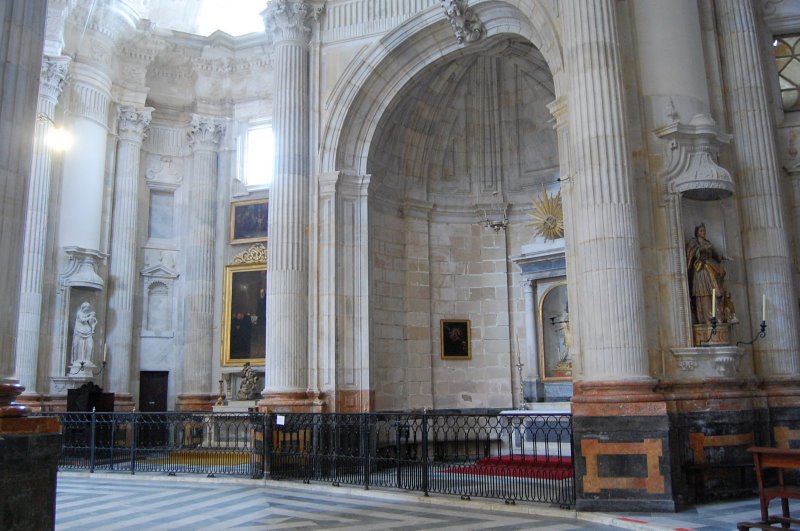
Half dome side chapels provide plenty of space for devotion to
particular saints. During construction, these housed the workshops of
the builders. The one below displays the large collection
of relics of saints in the wall displays.
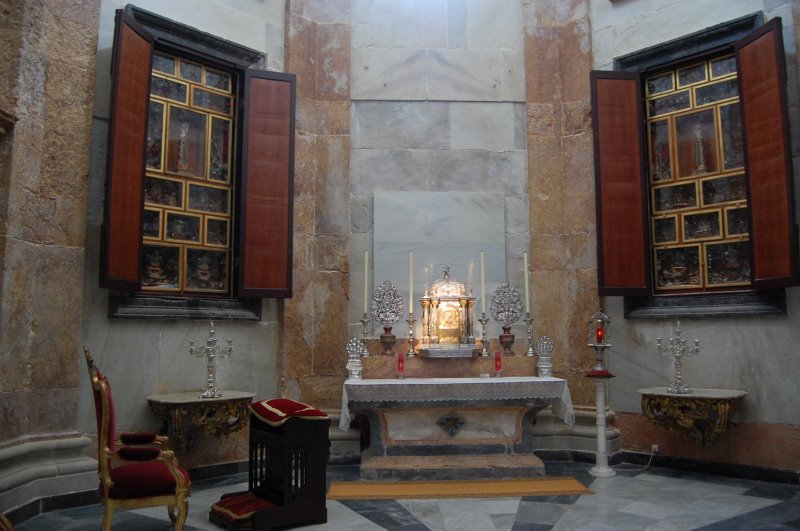
Still the party place long after the Roman fleet left, Cadíz
today has a huge Mardi Gras festival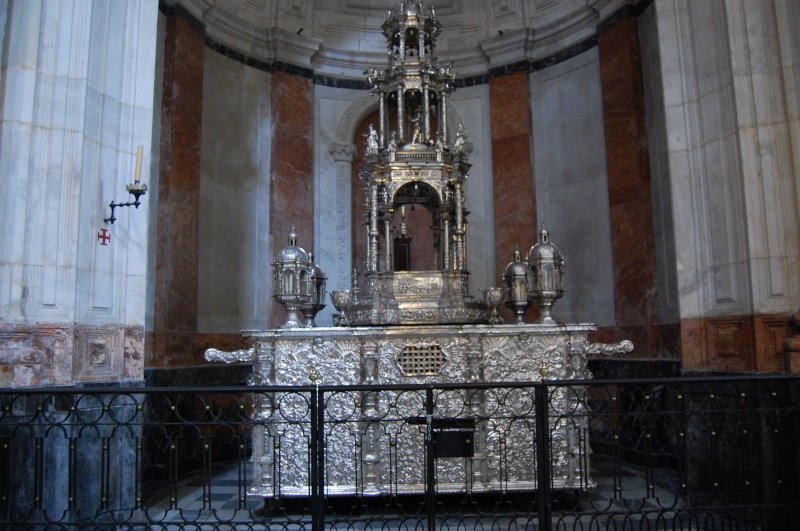 patterned
after
the Venetian festival. (Much trade occurred between Venice and
Cadíz). However, this silver float by Enrique de Arfe is
used
during the more somber religious processions on the feast of Corpus
Christi and during Holy
Week. Arfe was probably of German origin but did his best work in early
16th century Spain where gold and silver poured in from the colonies.
He started out Gothic but switched to Renaissance art right away. More
of his work can be found in the Cathedral museum across the plaza.
Processions are big in Cadíz and there are 30 associations
(called "brotherhoods") who carry floats through the streets.
patterned
after
the Venetian festival. (Much trade occurred between Venice and
Cadíz). However, this silver float by Enrique de Arfe is
used
during the more somber religious processions on the feast of Corpus
Christi and during Holy
Week. Arfe was probably of German origin but did his best work in early
16th century Spain where gold and silver poured in from the colonies.
He started out Gothic but switched to Renaissance art right away. More
of his work can be found in the Cathedral museum across the plaza.
Processions are big in Cadíz and there are 30 associations
(called "brotherhoods") who carry floats through the streets.
Furnishings
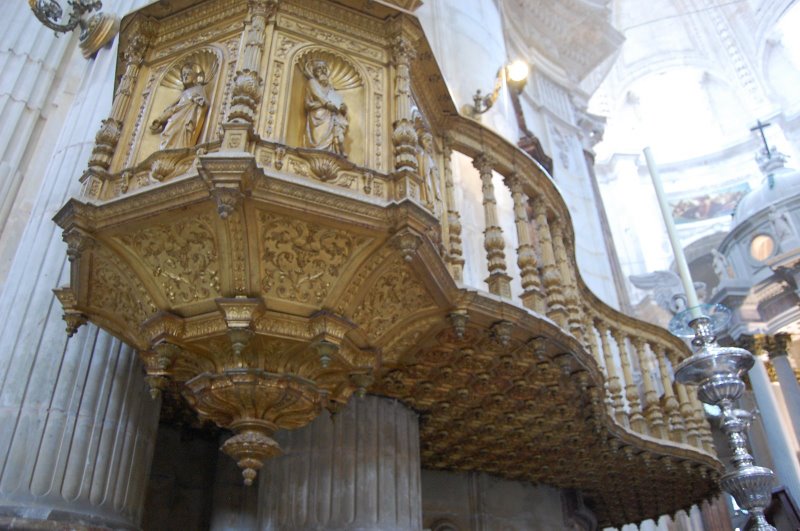
Above is a
closeup of one of the two gold
leaf pulpits. Even their bottoms is elaborately decorated.
The Crypt
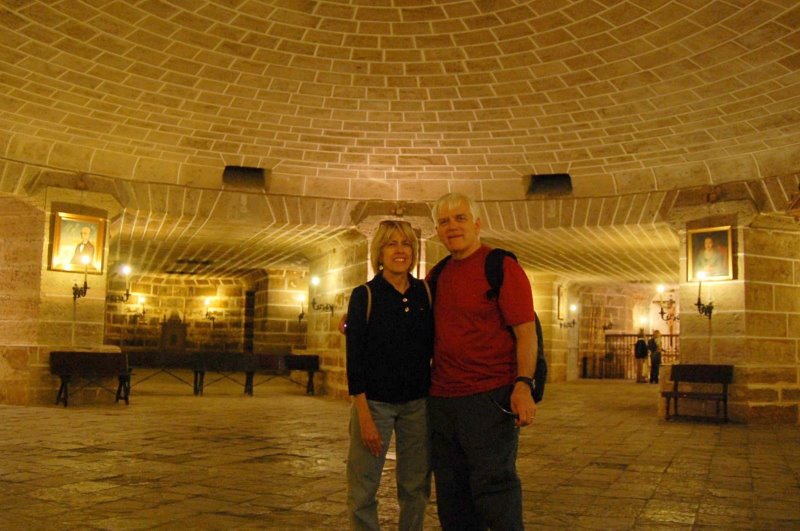
Below the church, a
huge crypt contains the
remains of many bishops as well as that of the composer
Manuel de Falla who was born in Cadíz. (We found these
sultry flamenco dancers above honoring his spirit.)
While most church crypts have small rooms and low ceilings resulting
from the huge pillars required to support the upper weight of their
churches, that was not the case here. The central area was very large
with no obvious means of support for th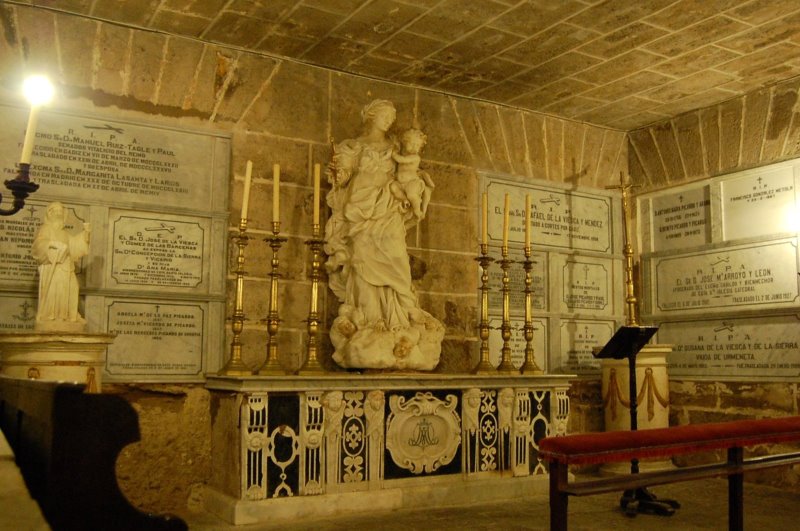 is circular room. This is even
more surprising when you consider that this crypt is below sea level --
and the Atlantic is only a few yards away from this spot. How do they keep this underground area dry
(and erect?) At right is a typical altar crypt area with
bishops stacked in the walls.
is circular room. This is even
more surprising when you consider that this crypt is below sea level --
and the Atlantic is only a few yards away from this spot. How do they keep this underground area dry
(and erect?) At right is a typical altar crypt area with
bishops stacked in the walls.
Plaza Fray
Félix
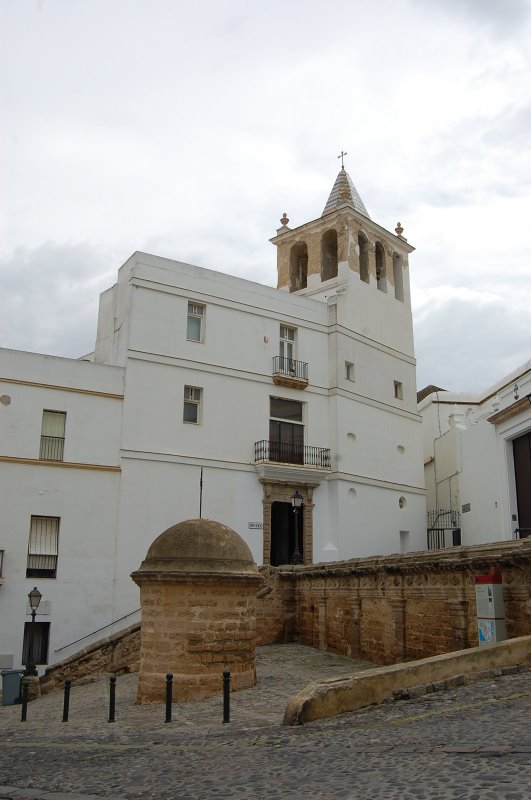 The tiny plaza at
left was once one of the most important squares in
Cadíz. It's called Plaza Fray (Friar) Félix and
is
bordered by the Cathedral Museum (above) and the old cathedral (not
shown at right.) These buildings seem to have been merged with the
tower
of the old cathedral which appears to have been once freestanding (and
because of that perhaps the minaret for the Moorish mosque which was
near this
site). Below this spot, the Romans built the second largest theater to
survive their empire. (If you call that survival: It was rediscovered
in the 1980s and is
undergoing restoration. Number one was that in Pompeii which obviously
spent its centuries buried as well.)
The tiny plaza at
left was once one of the most important squares in
Cadíz. It's called Plaza Fray (Friar) Félix and
is
bordered by the Cathedral Museum (above) and the old cathedral (not
shown at right.) These buildings seem to have been merged with the
tower
of the old cathedral which appears to have been once freestanding (and
because of that perhaps the minaret for the Moorish mosque which was
near this
site). Below this spot, the Romans built the second largest theater to
survive their empire. (If you call that survival: It was rediscovered
in the 1980s and is
undergoing restoration. Number one was that in Pompeii which obviously
spent its centuries buried as well.)
Later 17th century expansion added the ornate
stairway seen behind the little dome (which provided well access to a
cistern below).
Cathedral Museum
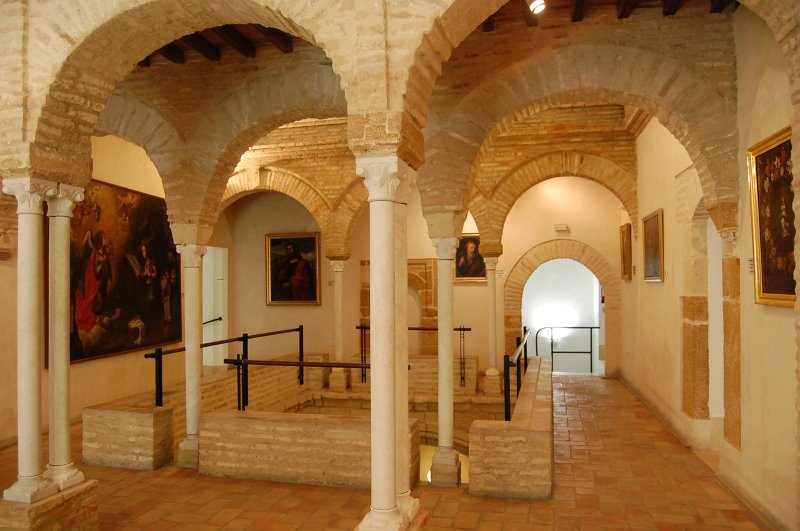
The cathedral museum (entrance area above) occupies several of these
merged structures
including the old accounting house for the cathedral chapter, built
right on top of the seats of the 1st century BC Roman theater. It was
merged with old cathedral tower and the Santa Cruz college which housed
clerics and altar boys serving the cathedral. Above is the Mudejar
patio
just behind the museum entrance. Most likely this medieval building
survived somehow when the Brits leveled the city in 1596. Most of the
city was then rebuilt in neo-Classical style. Parts of this complex are
very old with 7th century BC Phoenician remains underneath the Roman's
stones.
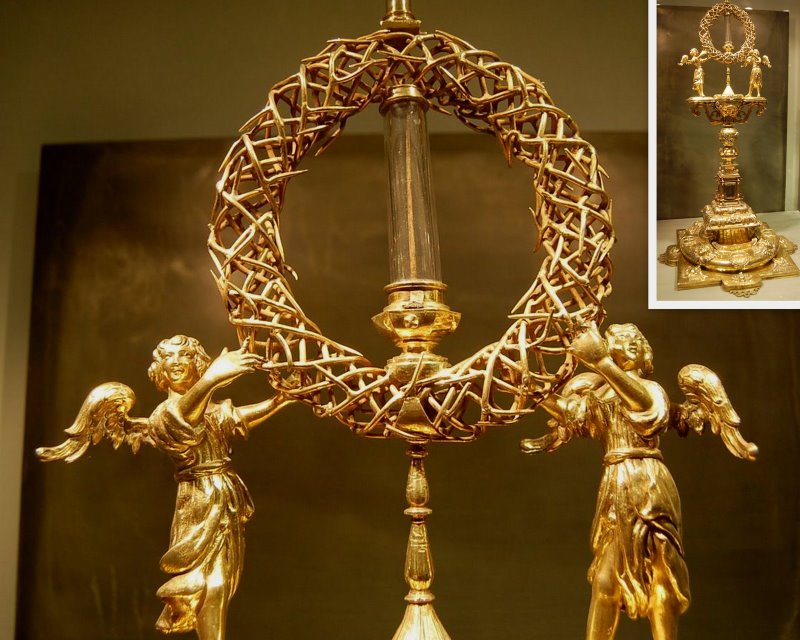
Inside these ancient rooms are outstanding religious vessels attesting
to the wealth that poured into Cadíz. Above we have a relic
of
the crown of thorns (note
the toothpick in the glass cylinder)
surrounded by rationally exuberant angels. Separate
exhibit rooms are
devoted for gold and silver works. In addition, exquisite marble
carvings such as crucifixes and many oil paintings are displayed.
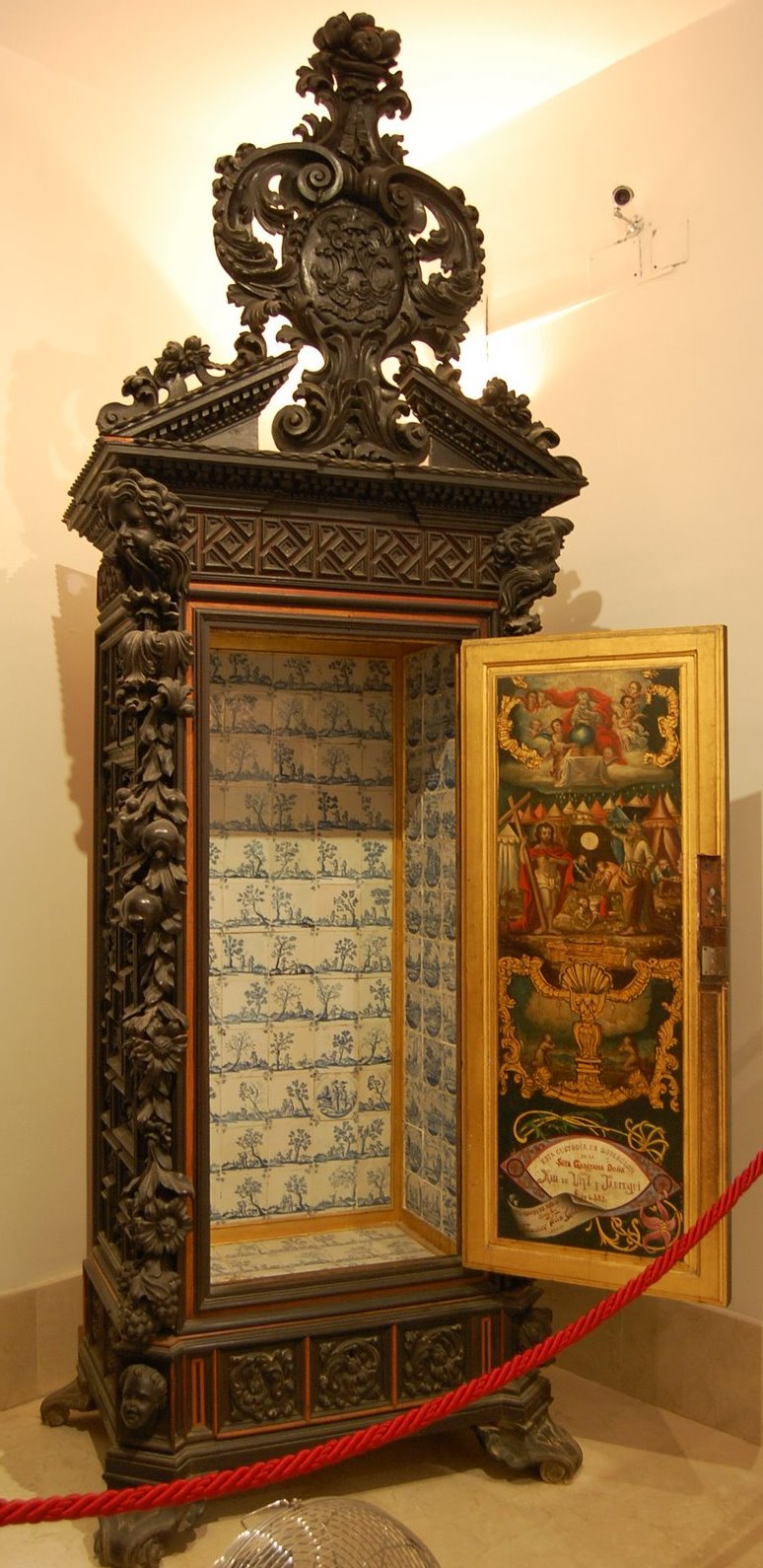
Elaborately carved repositories (left)
were
used inside the cathedral to lock
up the gold altar cups and monstrances. Shown here is one of the
two on display. The inside is Dutch tile with an inlaid wood
door. Thieves might consider emptying the safe --
and then carting it away.
(Picture below)
And you think you should clean up your bookshelves! Here we have the
choir books, so large that the entire ensemble could sing off the same
page.
Several were on display: Someone would have to turn these pages pretty
fast in these pre-Powerpoint days as the choir chanted from the
measure-less staffs. Perhaps this inspired Mitch Miller to "follow the
bouncing ball." (If you're too young to remember this, ask Mitch who,
as of this writing, is still alive and conducting at age 97.)
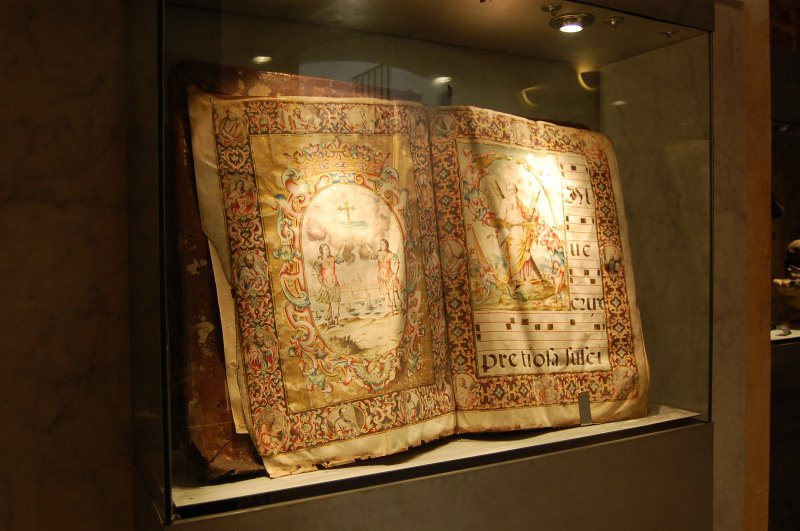
Connections
We were also enchanted by the
free WiFi service available to cafe
patrons lin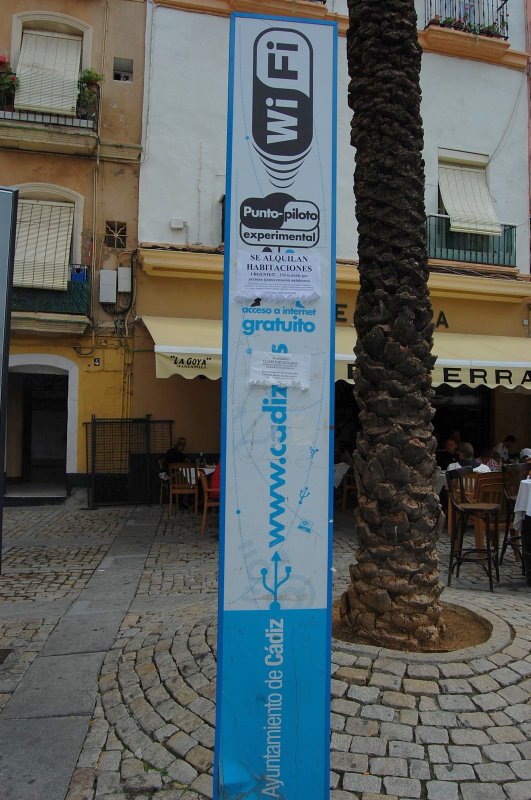 ing the edges of Cathedral
square, compliments of the city
government.
ing the edges of Cathedral
square, compliments of the city
government.
Unfortunately we found most of Cadiz's churches closed during our
visit. An exception was a chapel as small and baroque as the Cathedral
was large and neo-Classical. Please click here as we visit
the Oratorio of the Sacred Cave.
|
Please join us in the following slide show to give
Cadíz the viewing it deserves by clicking here.
|
|
Previous: Cadíz
Overview
Next: Oratorio
of the Sacred Cave
|
|
Geek and Legal Stuff
Please allow JavaScript to enable word definitions.
This page has been tested in Internet
Explorer 7.0 and Firefox 3.0.
Created on January 15, 2009
|
 |
TIP: DoubleClick
on
any word to see its definition. Warning: you may need to
enable javascript or allow blocked content (for this page only).
TIP: Click on
any picture to see it full size. PC users, push F11 to see
it even larger.
<
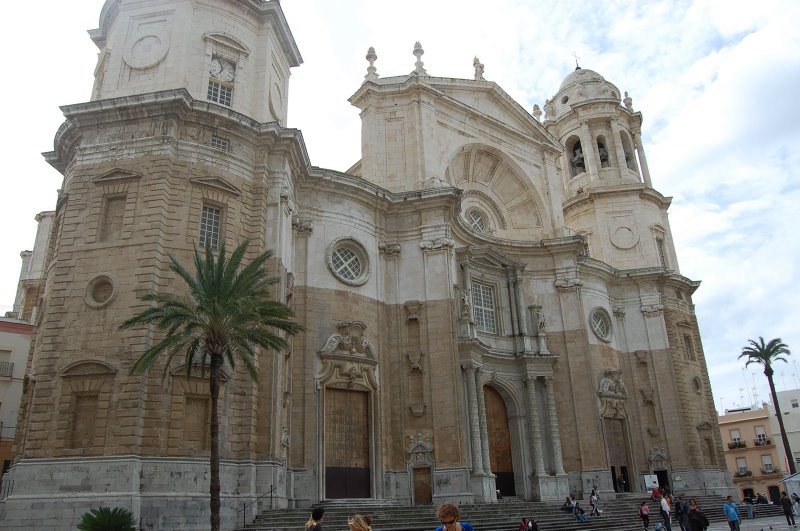

 At left: A view
from the back of the tabernacle whose double Corinthian columns suggest
an ancient Greek temple
At left: A view
from the back of the tabernacle whose double Corinthian columns suggest
an ancient Greek temple
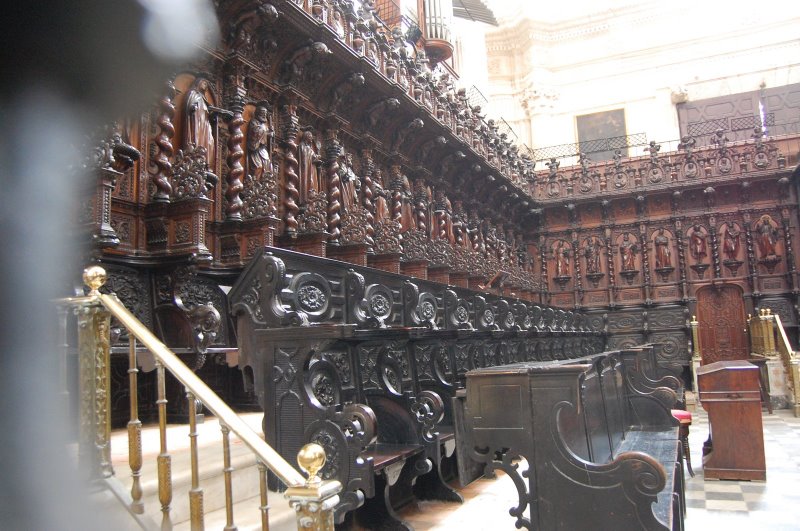
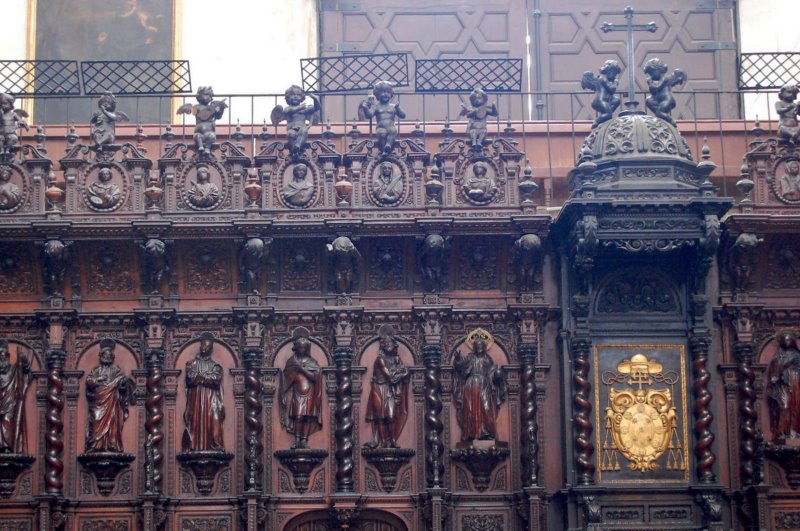
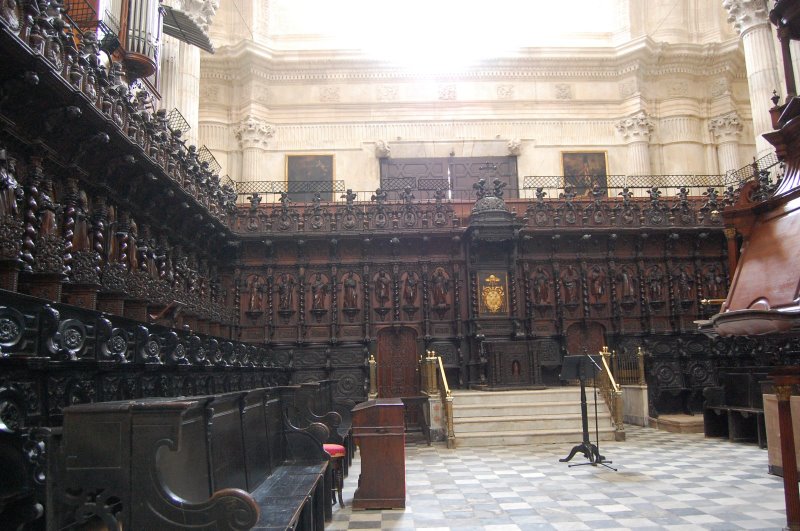


 patterned
after
the Venetian festival. (Much trade occurred between Venice and
Cadíz). However, this silver float by Enrique de Arfe is
used
during the more somber religious processions on the feast of Corpus
Christi and during Holy
Week. Arfe was probably of German origin but did his best work in early
16th century Spain where gold and silver poured in from the colonies.
He started out Gothic but switched to Renaissance art right away. More
of his work can be found in the Cathedral museum across the plaza.
Processions are big in Cadíz and there are 30 associations
(called "brotherhoods") who carry floats through the streets.
patterned
after
the Venetian festival. (Much trade occurred between Venice and
Cadíz). However, this silver float by Enrique de Arfe is
used
during the more somber religious processions on the feast of Corpus
Christi and during Holy
Week. Arfe was probably of German origin but did his best work in early
16th century Spain where gold and silver poured in from the colonies.
He started out Gothic but switched to Renaissance art right away. More
of his work can be found in the Cathedral museum across the plaza.
Processions are big in Cadíz and there are 30 associations
(called "brotherhoods") who carry floats through the streets.

 is circular room. This is even
more surprising when you consider that this crypt is below sea level --
and the Atlantic is only a few yards away from this spot. How do they keep this underground area dry
(and erect?) At right is a typical altar crypt area with
bishops stacked in the walls.
is circular room. This is even
more surprising when you consider that this crypt is below sea level --
and the Atlantic is only a few yards away from this spot. How do they keep this underground area dry
(and erect?) At right is a typical altar crypt area with
bishops stacked in the walls. The tiny plaza at
left was once one of the most important squares in
Cadíz. It's called Plaza Fray (Friar) Félix and
is
bordered by the Cathedral Museum (above) and the old cathedral (not
shown at right.) These buildings seem to have been merged with the
tower
of the old cathedral which appears to have been once freestanding (and
because of that perhaps the minaret for the Moorish mosque which was
near this
site). Below this spot, the Romans built the second largest theater to
survive their empire. (If you call that survival: It was rediscovered
in the 1980s and is
undergoing restoration. Number one was that in Pompeii which obviously
spent its centuries buried as well.)
The tiny plaza at
left was once one of the most important squares in
Cadíz. It's called Plaza Fray (Friar) Félix and
is
bordered by the Cathedral Museum (above) and the old cathedral (not
shown at right.) These buildings seem to have been merged with the
tower
of the old cathedral which appears to have been once freestanding (and
because of that perhaps the minaret for the Moorish mosque which was
near this
site). Below this spot, the Romans built the second largest theater to
survive their empire. (If you call that survival: It was rediscovered
in the 1980s and is
undergoing restoration. Number one was that in Pompeii which obviously
spent its centuries buried as well.)



 ing the edges of Cathedral
square, compliments of the city
government.
ing the edges of Cathedral
square, compliments of the city
government.